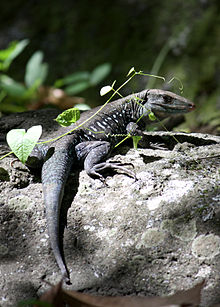Ameiva fuscata
| Dominican ground lizard | |
|---|---|
 |
|
| An adult male Dominican ground lizard near the Coulibistrie River, Dominica. | |
| Scientific classification | |
| Kingdom: | Animalia |
| Phylum: | Chordata |
| Class: | Reptilia |
| Order: | Squamata |
| Family: | Teiidae |
| Genus: | Ameiva |
| Species: | A. fuscata |
| Binomial name | |
|
Ameiva fuscata Garman, 1887 |
|
 |
|
| Endemic to Dominica in the Lesser Antilles, a chain of islands in the Caribbean. | |
| Synonyms | |
|
Pholidoscelis fuscatus (Garman, 1887) |
|
Pholidoscelis fuscatus (Garman, 1887)
The Dominican ground lizard or Dominican ameiva (Ameiva fuscata or, according to the most recent research, Pholidoscelis fuscatus) is a species of lizard. It is endemic to the Caribbean island of Dominica, an island noted for its intact and abundant reptile population, where it is most commonly found in dry coastal woodland.
Adults are mostly blue-gray, and can reach lengths up to 400 mm from snout to tail. They are omnivorous, feeding on fallen fruit, carrion, and small animals including other lizards.
The Dominican ground lizard is locally known as the abòlò. The indigenous Caribs used to stew it as a remedy for certain illnesses.
The species was first described in 1887 by Samuel Garman, the assistant director of herpetology and ichthyology at Harvard's Museum of Comparative Zoology. The three cotype specimens, all males of varying ages, were acquired by the Museum in 1879, and were collected from Dominica during the "Blake expeditions" conducted by William Healy Dall.
Adult Dominican ground lizards have bright blue spots on their flanks and inner thighs, and a gray or sometimes reddish-brown dorsal surface that is flecked with black. They have a pale blue ventral surface, with dark blue-gray on the throat and chest. They exhibit little sexual dichromatism, apart from a tendency in the males to be more uniformly blue-gray. Adult males can reach a snout-vent-length (SVL) of up to 200 mm, females up to 154 mm SVL, with their tails about the same length. Adult males also have broader heads and jowls.
Juveniles appear markedly different from adults and are impossible to sex from simple observation. They are coppery-brown overall, with a dark brown lateral stripe on each side bounded by yellow lines. These stripes have yellow flecks and spots that turn blue as it matures. Juveniles are often confused with adult Gymnophthalmus pleei and Mabuya mabouya, two other lizard species present in the same habitat, because they are fast moving and of similar coloration and size. The latter two may be differentiated from juvenile Dominican ground lizards by their shinier skin and less differentiated, snake-like head and body.
...
Wikipedia
